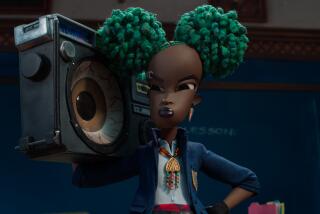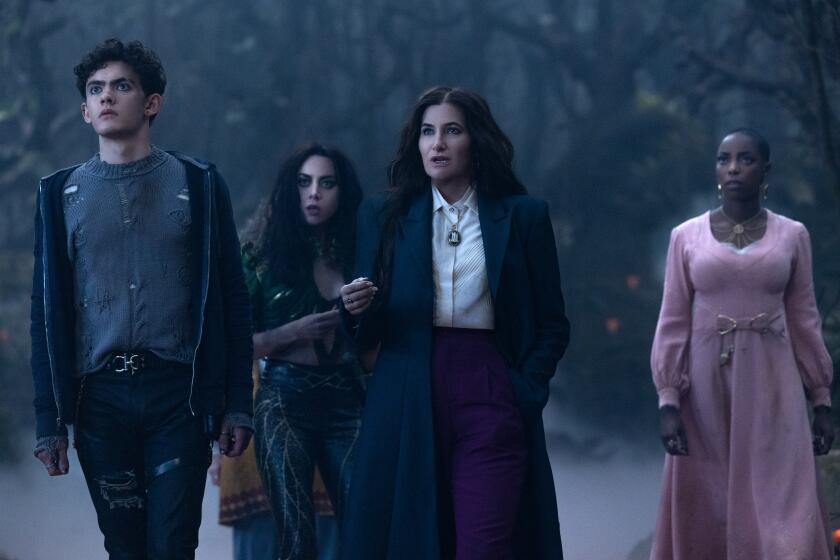He’s tooned in and turning it out
His name may not be as familiar to cartoon lovers as those of Chuck Jones, Tex Avery, Bill Hanna or Joe Barbera, but there’s hardly a baby boomer in America who has not seen the work of Gene Deitch.
Perhaps best known as the creator of “Tom Terrific” from “Captain Kangaroo,” Deitch is also an Oscar-winning director with more than a thousand cartoon films to his credit.
Deitch, who has lived and worked in Prague for more than 40 years, will receive the Winsor McCay Award for Lifetime Achievement at the Annie Awards, the toon industry’s Oscars, at the Alex Theatre in Glendale on Saturday.
Then on Tuesday, some of the best of his work will be screened at the Egyptian Theatre in Hollywood in a tribute sponsored by the American Cinematheque and the International Animated Film Society, ASIFA-Hollywood, the latter of which also puts on the Annies.
“He’s had an incredible body of work that most people, even those in the animation community, are completely unaware of,” says animation historian Jerry Beck, who is coordinating the screenings at the Cinematheque.
“Deitch is the missing link on the family tree of subversive animation,” Beck says, tracing the line from John Hubley to Deitch to Ralph Bakshi to Bakshi’s protege, John Kricfalusi, the creator of “Ren and Stimpy.” “The Terrytoons he did are just amazing.” One of the best is the 1958 fable “The Juggler of Our Lady,” based on a book by R.O. Blechman and narrated by Boris Karloff, a CinemaScope print of which will be screened at the Egyptian.
Although he’s happy to make a rare trip to the United States, Deitch is philosophical about the tributes.
“In the early and mid-’50s, I started getting all the recognition I wanted,” the 79-year-old, Chicago-born animator says.
Deitch’s career in animation began in 1946 when he joined the groundbreaking Hollywood animation studio UPA as an assistant to animators Hubley, Bill Hurtz and Robert “Bobe” Cannon. UPA’s trademark linear, stylized look would influence his later work. He earned his director’s stripes at the Jam Handy Organization, a Detroit-based industrial animation company, and by 1951 he was back at UPA, this time as creative director of its New York-based commercial studio.
Among his award-winning spots (among the first commercials to be screened at New York’s Museum of Modern Art in the 1950s) were the famous “Bert and Harry Piels” commercials for Piels Beer.
In 1956 Deitch was hired as creative director for the threadbare Terrytoons Studios, which had just been bought by CBS. “I was taking over probably the junkiest animation studio in the world,” Deitch laughs. “They had the lowest standards and [producer Paul] Terry was only interested in turning stuff out mechanically to make money.”
Deitch revitalized the studio, bringing in a group of fresh young artists that included Jules Feiffer and Ernie Pintoff, and encouraging the rise of Bakshi, a young cel painter. As a result, the vaudevillian antics of Heckle and Jeckle and Gandy Goose were replaced with newer, hipper characters like building superintendent Clint Clobber and the Oscar-nominated “Sick, Sick Sidney,” about a neurotic elephant, which more closely reflected the burgeoning stand-up comedy movement than any animated precedent.
A studio political struggle ended Deitch’s Terrytoons tenure, but he soon came to the attention of producer William L. Snyder, whose Rembrandt Films was one of the few American companies with ties in what was then communist Eastern Europe. Snyder agreed to finance “Munro,” a Deitch short based on a Feiffer story about a young boy drafted into the army (it won the 1960 Oscar for animated short), if Deitch would go to Prague to supervise a project for him.
“I had a signed contract saying that I didn’t have to stay in Prague more than 10 days,” Deitch says. “It’s 43 years later, and I’m still here!” (Falling in love and marrying the Czech studio’s production manager was a major factor.)
In between such personal projects as “Nudnik,” a cartoon series about a hapless, if happy, striver against fate, Deitch took on a lot of bread-and-butter work, such as cartoons starring Tom and Jerry, Popeye and Krazy Kat and adaptations of children’s books such as “Anatole.”
Deitch has remained in the children’s book adaptation business through a 30-year association with Weston Woods, a company that specializes in animated versions of classic kid-lit in the original illustrators’ styles for the school and library markets.
“Although what I’ve done for Weston Woods is probably the least-known in the world of animation, they’re the films I’m most proud of,” he says. He is currently finishing up his latest collaboration with Feiffer, “I Lost My Bear,” which is scheduled to be shown at the Egyptian.
A lifelong fan of jazz and onetime cartoonist for the Record Changer magazine, Deitch recently set the music world buzzing by making public a 1949 recording of John Lee Hooker, whom he privately taped in Detroit, which is to be released commercially.
Happily married, Deitch has no plans to leave Prague anytime soon. And in an industry rife with credit-grabbing, he remains remarkably content with his standing.
“I’m not one of the really big stars of animation,” Deitch says, “but I’ve won the Oscar, I’ve got five nominations, I’ve got a hundred other prizes from children’s film festivals, I get lots of letters from people, so I’ve got all the satisfaction I could possibly want.”
More to Read
The biggest entertainment stories
Get our big stories about Hollywood, film, television, music, arts, culture and more right in your inbox as soon as they publish.
You may occasionally receive promotional content from the Los Angeles Times.










